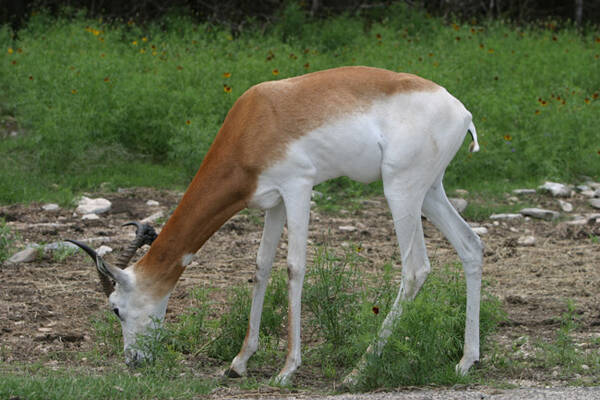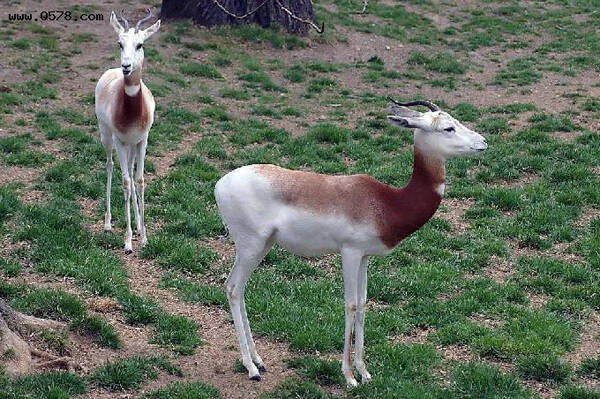Nanger dama
IUCN
LCBasic Information
Scientific classification
- name:Nanger dama
- Scientific Name:Nanger dama,Fallow deer gazelle, Damma gazelle
- Outline:Ungulata
- Family:Artiodactyla Bovidae Antelope
Vital signs
- length:140-165cm
- Weight:35-75kg
- lifetime:About 15 years
Feature
It is the largest species of all antelopes.
Distribution and Habitat
Origin: Chad, Mali and Niger.
Extinct: Libya, Mauritania, Morocco, Nigeria and Tunisia.
Uncertain presence: Sudan and western Sahara.
Reintroduced: Senegal.
Uncertain presence and wandering: Algeria.
The antelope inhabits the Sahelian steppes, including savannas, semi-desert areas with acacia and millet vegetation, plains, hills and mountainous areas. Generally avoids truly sandy areas, but often occurs in low mountains and plateau areas. Lives in the Sahara Desert in Africa, migrating seasonally, forming larger groups of several hundred individuals, moving south in the dry season to find food and returning to the north during the rainy season. Generally, it survives in arid areas with sparse vegetation. However, due to the seasonal migration of the animal, its habitat changes little throughout the year. The species lives in pastures and plateaus of the Sahara Desert during the rainy season and moves to open scrub during the dry season. They avoid the area's mountai
Appearance
The head and body length of the antelope is 140-165 cm, the shoulder height is 90-120 cm, and the tail length is 25-35 cm. Their size also varies with sex, with females usually weighing 35-40 kg and males between 40-75 kg. It is the largest species of all small antelopes. It has thin legs and a slender neck, as well as S-shaped horns, which are larger and stronger in males. The fur is shiny with reddish brown and white spots. The cheeks and underparts are always white, the neck is reddish brown, and there is always a white spot on its throat. However, the coloring varies between subspecies. The horns of these animals are shaped like the letter S, pointing backwards and curling upwards. The length of the horns is usually between 25-35 cm, and males are slightly larger than females.
There are 3 subspecies of the antelope, and the coloring varies greatly. The degree of coloring increases from east to west in the distribution range. The eastern subspecies (Nanger dama ruficollis) is mai
Details
Nanger dama (scientific name: Nanger dama) is also known as Dama Gazelle, Addra Gazelle, and Mhorr Gazelle. There are three subspecies.

Nanger dama migrates for a long time, moving into the Sahara Desert in the rainy season and to the open jungle in the dry season. When in the desert, they live together in large groups, sometimes as many as several hundred. In the bush, they usually gather in small groups of about 10-20. There are matriarchal groups (only females and their young) and bachelor groups (only males), but many groups consist of a dominant male, several females, and several young ibex. The ibex is generally a social animal, living in herds. In small mixed groups of the species, there is a hierarchy, and the dominant male can mark his identity by standing upright to be distinctive, and also by cutting through bushes and grass. Males often threaten with their horns, shake their heads, and "pretend" to fight, to show their strength.
The ibex faces many predators, including jackals, cheetahs, spotted hyenas, and lions. Escape is their main means of defense, and they are very well adapted to running. When a stag spots a predator, they adopt a wary posture and often stamp their feet, walk in circles, twitch their flank skin and sneeze to warn other members of the tribe. Most communication in this species is done through body language. For example, an upright posture shows aggression and high status and is also used in sexual displays. Males may also tilt their heads or butt to attract the attention of other stags to their horns. Submission, on the other hand, is often shown by lowering the head or protruding the chin. Turning or moving away is also used as a way to indicate submission. These animals also use scent, and all members of the same tribe urinate and defecate as a way to mark their territory from outsiders. Males have been known to sneeze during sexual intercourse.
Stags are herbivores that feed on shrubs, grass leaves, coarse desert grasses and leaves of acacia trees. These stags usually stand upright in a bipedal manner on their hind legs in order to reach the higher branches of these trees. The species is hardy and heat tolerant, and can go weeks without water, getting most of the water it needs from the plants it eats. The antelopes eat the leaves of the acacia tree to disperse seeds, and they are also a food source for many carnivores that live and hunt on the plains.

Mating occurs year-round, but mainly between August and October. The mating season can begin as early as August and end in late October. During this time, males occupy territories and engage in behaviors that indicate their aggression and status. They often urinate or defecate to mark their territory and call to assert their power and status. Males also chase and run to keep females and other nearby males away. Male courtship behaviors often include prancing, raising their noses, standing upright, kicking with their forelimbs, and touching or licking the female with their muzzle. Some males may even sneeze to get their mate's attention. Receptive females often circle, make sharp turns, and hold their tails out to indicate that they are ready to mate. Males stand on their hind legs with their front legs draped over the huddled female's body. It is common for females to continue moving during mating.
The female's estrus cycle usually lasts about 19 days, although it can be as short as 16 days or as long as 22 days. Usually, the species gives birth to one offspring at a time, and in rare cases twins are born. When the young are first born, the mother will isolate the newborn from the rest of the herd. After a few days, the young are strong enough to follow their mother into the grasslands and into mixed herds of other gazelles. Female gazelles invest a lot of energy in protecting their young. It is common for two females to join forces to defend their offspring, as pairs of females can often be observed chasing and attacking jackals hunting young gazelles.
Since the 1950s and 1960s, the number of gazelles has declined sharply. In the early 1970s, the population in the Ouadi Rime - Ouadi Achim Faunal Reserve in Chad (one of the main distribution areas of the species) was estimated at 10,000-12,000, but the species was already very rare in the reserve. The known remaining population is very small and very fragmented, mostly in Chad, eastern Niger and the Mali/Niger border area. In all areas surveyed, numbers are very low and small groups of small animals (range = 1-5 individuals) have been observed (2007). In all cases, subpopulations may be around 20 individuals, separated by hundreds of kilometers, and the total number of wild populations remaining is definitely less than 500. The antelope was listed as endangered in 2004, with an 80% decline in numbers in a decade, making it a critically endangered species. It is mainly found on the African continent, with no more than 100 individuals in the wild and a total population of less than 2,000 individuals. It is found in captivity in zoos in Africa, Europe and the United States.

The tropical savannahs on the edge of the Sahara were once home to the antelope. There are three subspecies of antelope. The western subspecies (also known as the Muhor young gazelle) is the westernmost and darkest subspecies. It is particularly endearing for its elegant figure and bright fur. It has been extinct in the wild since 1968. In 1971, 11 of the western subspecies were brought to the Almeria breeding farm in southern Spain to conserve Saharan species. More than 200 Muhor gazelles live in zoos around the world, and they all developed from this.
Hellabrunn Zoo in Germany, together with the German Technical Cooperation Agency (GTZ), Frankfurt Zoo and Berlin Zoo, has carried out a project to reintroduce the gazelles from Hellabrunn Zoo to the Tunis and Monaco National Parks. Thanks to this successful work, more than 60 gazelles have returned to their homeland since 1997. Although they have been bred for several generations in European zoos, and some of them were even fed with milk bottles, the gazelles have adapted very well to the new and unfamiliar environment. They even ignore the preset drinking water points and completely regain their semi-desert nature, getting the water they need from their food. The leaves of the prickly pear cactus or the fruit of the desert pumpkin are their main source of water, the latter of which is so bitter that even livestock are reluctant to eat it. The antelope can also nimbly and freely eat tender leaves from the thorny acacia trees without any harm. This is the main food source of their ancestors.
The antelope is very picky about European grass feed, and this "knowledge" is obviously stored in their genes. Just one day after releasing these little guys into the wildlife sanctuary, their escape distance has exceeded 3,100 meters. It seems that the antelope has quickly found a sense of home in this place where their ancestors have lived and multiplied for generations.
Listed in the "Red List of Endangered Species of the World Conservation Union" (IUCN) 2008 ver3.1-Critically Endangered (CR).
Listed in the CITES I level protected animals of the Washington Convention.
Listed in Appendix I, Appendix II and Appendix III of the Convention on International Trade in Endangered Species of Wild Fauna and Flora (CITES) 2019 Edition.
Protect wild animals and eliminate game.
Maintaining ecological balance is everyone's responsibility!








